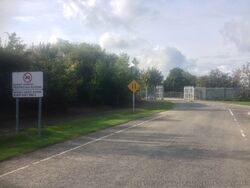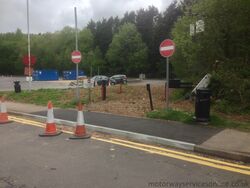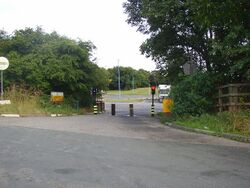Rear Access
A rear access, better known as a 'secret exit', also known as a 'rear exit' or 'side exit', is a road which allows people to get from the service area to the local road network without using the main entrance (a motorway sliproad).
They are provided to provide staff, highway vehicles, hotel guests and the emergency services access to the service area and the wider motorway network without having to make a lengthy detour up to the next junction.
In some areas, recruiting local staff for a low-paid service station job is difficult, and the time saved by not having to drive up to the next motorway junction (which also means you can walk or cycle to work) can help kerb staffing difficulties.
Operators are required to prevent anybody else from using them.
Enforcement
Most service areas are fitted with either rising bollards, barriers or a number plate recording system, to prevent unauthorised traffic. In practice, most of those systems are either broken or not used. In some areas new security measures have been vandalised within weeks of being installed.
While police enforcement is rare, it does happen. A common trick is to park the police car out of sight at the end of the road, and stop everybody caught using the lane. Whether or not a fine can be issued depends on the quality of the signage at that particular location, but the presence of 'no entry' signs would normally be enough: the signage is only really confusing for hotel guests.
Police enforcement varies by region, and is often prompted by complaints from residents or the highway authority. While most complaints about unauthorised traffic stem mostly from the residents who have to contend with it, most of the unauthorised traffic is also people living locally.
In some areas, enforcement is virtually non-existent, and unauthorised vehicles can be seen using the rear access every five minutes. Many of them have been included on Google Street View and some unscrupulous estate agents have been known to use them to advertise a property having good motorway access.
Safety Issues

There are several reasons general traffic is not allowed to use the rear access.
The first is quite simply that it's an operational requirement. Government policy states that people must not be able to join the motorway via a service station, so the operators must ensure that is the case. More recently a planning condition will also be imposed on service stations saying the same thing. Even if the unauthorised traffic is only trying to use the facilities, the policy is clear that the service area's priority should be to serve motorway traffic.
Secondly, especially in the case of the older services, the lanes these rear accesses connect to are not designed to handle much traffic at all. They were usually built at the same time as the motorway but with the minimal possible expenditure. They are narrow, and may take traffic into residential or congested areas.
At the service station end, there is often an unconventional road layout. At some services, the rear access requires traffic to travel the wrong way down the one-way road, while others end with confusing or badly-aligned junctions. This isn't so bad when the only people using it are staff who have been trained on the issue, but becomes a problem when the general population are using it.
Finally, when people are taking a shortcut - especially when they don't want to get caught - they tend to speed up. The high speeds which unauthorised traffic has been seen reaching on these narrow lanes creates additional safety issues, especially if they are heading straight into the service area car park or a residential area.
History
Rear accesses were a standard feature of service area design from the very start.
As early as 1961, the Ministry of Transport were complaining about the gates at Newport Pagnell having been left open. They were shocked that three vehicles being seen abusing it in 10 minutes - particularly impressive when you consider how empty the motorway would have been at the time!
At one stage rear accesses were considered so important to service area design that one service area considered on the M1 in the 1960s would have had both rear accesses bridge a railway line: a considerable investment for what was basically an optional extra.
When Rownhams was planned in 1971, local residents were deeply concerned about the Rear Access being abused. This became a regular topic of correspondence as soon as it opened in 1976. In 1978 the Department of Transport eventually admitted that they had no suggestions as to how this could be addressed.
Despite staff not wanting to get out and lock it, a gate and padlock remained the only way of securing these exits until 1977, when Keele trialled a rising bollard system. Being close to the University, Keele was a popular shortcut for students. The rising gate was too expensive to roll out immediately, and frequently attracted vandalism.
With the creation of lodges, the Department for Transport reluctantly accepted the idea that lodge traffic can turn around using the rear access. By 2008 this was stopped for all new lodges, and it is starting to be phased out nationwide.
With more families owning a car and fewer deliveries coming from the local area, rear accesses became less important, although they continued to be included for convenience. In 2008, a new rule was introduced stating that all new services must have the rear access permanently sealed off. This means emergency traffic can use the rear access to get to the service area, but not to join the motorway.
Services with Rear Accesses

Here is a comprehensive list of all the services with a rear access and the road they join on to. Several unbuilt services have been included if it was clear there would have been a rear access.
UK services are listed first, with the five Irish examples at the end.
M1:
- London Gateway - Ellesmere Avenue
- Toddington - B530
- Newport Pagnell - Little Linford Lane
- Watford Gap - Station Road
- Lutterworth - Swanford Road (not built)
- Leicester Forest East - Baines Lane
- Long Whatton - Dry Pot Lane (northbound), Smithy Lane (southbound) (not built)
- Trowell - Waterloo Lane
- Tibshelf - Newton Wood Lane (originally going to be Saw Pit Lane)
- Woodall - A618 Rotherham Road
- Woolley Edge - Bramley Lane
M2:
- Medway - Matts Hill Road
M3:
- Trumps Green - Kitsmead Lane (south-westbound only)
- Fleet - Pale Lane
- Kempshott - Beggarwood Lane (north-eastbound), Garlic Lane (south-eastbound) (not built)
- Winchester - Chillandham Lane (south-eastbound only, now closed)
M4:
- Heston - North Hyde Lane (northbound), Phoenix Way (southbound) - unusual in that "M4 diverted traffic" signs point down both roads
- Reading - Deans Copse Road (westbound)
- Membury - Ramsbury Road
- Leigh Delamere - Honey Knob Hill
- Pucklechurch - Westerleigh Road (westbound), Batchfield Lane (eastbound) (not built)
M5:
- Frankley - Illey Lane (northbound), Ravenhayes Lane (southbound)
- Newland Common - Tagwell Road (northbound), Trench Lane (southbound) (not built)
- Strensham - Hill View Road
- Gloucester - Winnycroft Lane (northbound only)
- Michaelwood - Mule Street (northbound), Wick Lane (southbound)
- Moreton Valence - Standish Lane (not built)
- Sedgemoor - Strowland Lane (northbound), Mendip Road (southbound)
- Taunton Deane - Lowton Road (northbound), unnamed road (southbound)
M6:
- Harborough Magna - Montilo Lane (not built)
- Corley - Highfield Lane (north-westbound), Smorral Lane (south-eastbound)
- Hilton Park - Hilton Lane
- Doxey - Seighford Road (northbound), Aston Bank (southbound)
- Stafford - Eccleshall Road (northbound), Eccleshall Road (southbound, alternative plan)
- Keele - Three Mile Lane
- Sandbach - A533 The Hill
- Knutsford - A5033 Northwich Road
- Newton-le-Willows - Rob Lane (northbound), Newton Lane (southbound)
- Charnock Richard - Mill Lane
- Lancaster - unnamed road (northbound), Greaves Hill Lane (southbound)
- Burton-in-Kendal - Tarn Lane
- Killington Lake - Fairthorns Road
- Tebay - unnamed road
- Southwaite - unnamed road
- Norton Canes - Betty's Lane
M8:
- Heart of Scotland (Harthill) - Miller Street (westbound), B718 Westcraigs Road (eastbound) (both pedestrians only)
M12:
- Havering-atte-Bower - B175 North Road (not built)
M18:
- Hatfield - Mill Hill Road (northbound), New Mill Field Road (southbound) (not built)
M25:
- Clacket Lane - Clacket Lane
- Iver - Thorney Lane South/A4007 Slough Road (different plans, neither built)
M27:
- Rownhams - Rownhams Lane
- Meon Valley - Whiteley Lane (not built)
M40:
- Warwick - Fosse Way
M48:
- Severn View - Sandy Lane (no through route)
M42:
- Catherine-de-Barnes (M42) - B4102 Solihull Road (not built)
- Tamworth - Green Lane
M61:
- Bolton West - Anderton Lane (now closed)
M62:
- Birch - Whittle Lane
- Hartshead Moor - Highmoor Lane
- Ferrybridge - Cattlelaith Lane (no through route)
- Hensall - Moor Lee Lane (not built)
- Sprotbrough - Melton Road (not built)
A14:
- Newmarket - Heath Road (eastbound)
A34:
- Sutton Scotney - Barton Road (northbound), By Pass Road (southbound)
A40:
- Monmouth - Groesenon Road (north-westbound), unnamed road (south-eastbound)
Ireland:
- M1 Castlebellingham - L1182
- M1 Lusk - unnamed road
- M4 Enfield - L1003
- M11 Gorey - L1003
- M9 Kilcullen - L6091

